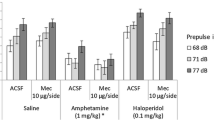Abstract
Rats were permitted to turn on and off electrical stimulation of the medial forebrain bundle, by alternating between two photobeams running along opposite walls of a shuttle box. Entry into one beam (the “ON” beam) triggered the delivery of a succession of short, regularly occurring (1 Hz) pulse trains, which could be terminated by breaking the other (“OFF” beam). The two beams were frequently reversed. When this occurred, the rat was given a free period of 10 s in which to reorient, and brain stimulation reward was then assessed by the amount of time spent receiving brain stimulation (SST) within a fixed interval of time. SST increased with increasing current intensity.
After training, subjects were tested for 10 consecutive days, alternately with saline and nicotine bitartrate (0.4 mg/kg SC base), and received a constant daily dose of the drug (0.4 mg/kg). Initially, nicotine visibly impaired motor performance for several minutes after injection, which may at least partly explain the observed reduction of SST; both effects waned across successive nicotine tests. Later in each 78 min session, nicotine consistently increased SST over a range of current, and drugged subjects entered the photobeams more frequently even when electrical stimulation was unavailable. d-Amphetamine sulphate (0.25, 0.75 mg/kg SC salt), given 15 min before testing, also increased SST and stimulated responding. The possible effects of motor impairment or activation on SST are discussed, and it is concluded that nicotine and d-amphetamine may have enhanced the rewarding properties of medial forebrain bundle stimulation.
Similar content being viewed by others
References
Atrens DM (1970) Reinforcing and emotional consequences of intracranial self-stimulation of subcortical limbic-forebrain. Physiol Behav 5:1461–1471
Cassens GP, Mills AW (1973) Lithium and amphetamine: opposite effects on threshold of intracranial reinforcement. Psychopharmacology 30:283–290
Christopher SM, Butter CM (1968) Consummatory behaviours and locomotor exploration evoked from self-stimulation sites in rats. J Comp Physiol Psychol 66:335–339
Clarke PBS, Kumar R (1983a) The effects of nicotine on locomotor activity in non-tolerant and tolerant rats. Br J Pharmacol 78:329–337
Clarke PBS, Kumar R (1983b) Nicotine does not improve discrimination of brain stimulation reward by rats. Psychopharmacology 79:271–277
Clarke PBS, Kumar R (1983c) Characterization of the locomotor stimulant action of nicotine in tolerant rats. Br J Pharmacol 80:587–594
De Groot J (1959) The rat forebrain in stereotactic coordinates. Trans R Neth Acad Sci 52:No. 4
Domino EF, Lutz MP (1973) Tolerance to the effects of daily nicotine on rat bar pressing behaviour for water reinforcement. Pharmacol Biochem Behav 1:445–448
Hendry JS, Rosecrans JA (1982) The development of pharmacological tolerance to the effects of nicotine on schedule-controlled responding in mice. Psychopharmacology 77:339–343
Liebman JM, Butcher LL (1974) Comparative involvement of dopamine and noradrenaline in rate-free self-stimulation in substantia nigra, lateral hypothalamus, and mesencephalic central gray. Naunyn-Schmiedeberg's Arch Pharmacol 284:167–194
Lyon L, Robbins TW (1975) The action of central nervous system stimulant drugs: a general theory concerning amphetamine effects. In: Essman WB, Valzelli L (eds) Current developments in psychopharmacology, vol 2. Spectrum, New York, pp 79–163
Morrison CF, Stephenson JA (1972) The occurrence of tolerance to a central depressant effect of nicotine. Br J Pharmacol 46:151–156
Newman LM (1972) Effects of cholinergic agonists and antagonists on intracranial self-stimulation behaviour in the rat. J Comp Physiol Psychol 79:394–413
Olds J, Domino EF (1969) Comparison of muscarinic and nicotinic agonists on self-stimulation behaviour. J Pharmacol Exp Ther 166:189–204
Olds ME, Olds J (1963) Approach-avoidance analysis of rat diencephalon. J Comp Neurol 120:259–295
Poschel BPH, Nintemann FW (1966) Psychotropic drug effects on self-stimulation of the brain: a control for motor output Psychol Rep 19:79–82
Pradhan SN (1970) Effects of nicotine on several schedules of behaviour in rats. Arch Int Pharmacodyn Ther 183:127–138
Pradhan SN, Bowling C (1971) Effects of nicotine on self-stimulation in rats. J Pharmacol Exp Ther 176:229–243
Roberts WW (1958) Both rewarding and punishing effects from stimulation of posterior hypothalamus of cat with same electrode at same intensity. J Comp Physiol Psychol 51:400–407
Schaefer GJ, Holtzman SG (1979) Free-operant and auto-titration self-stimulation procedures in the rat: a comparison of drug effects. Pharmacol Biochem Behav 10:127–135
Shizgal P, Matthews G (1977) Electrical stimulation of the rat diencephalon: Differential effects of interrupted stimulation on on- and off-responding. Brain Res 129:319–333
SPSSX Users Guide, SPSS Inc., McGraw-Hill, New York
Stitzer M, Morrison J, Domino EF (1970) Effects of nicotine on fixed-interval behaviour and modification by cholinergic antagonists. J Pharmacol Exp Ther 171:165–177
Szabo I, Milner PM (1972) Self-stimulation in rats: Tip alignment influences the effectiveness of bipolar electrodes. Brain Res 48:243–250
Valenstein ES (1964) Problems of measurement and interpretation with reinforcing brain stimulation. Psychol Rev 71:415–437
Valenstein ES, Meyers W (1964) A rate-independent test of reinforcing consequences of brain stimulation. J Comp Physiol Psychol 57:52–60
Wanner HU, Bättig K (1966) Wirkung von Nicotin and Amphetamin auf die Selbstreizung bei der Ratte. Helv Physiol Pharm Acta 24:C122-C124
Zarevics P, Setler PE (1979) Simultaneous rate-independent and rate-dependent assessment of ICSS: Evidence for the direct involvement of dopamine in brain reinforcement mechanisms. Brain Res 169:499–512
Author information
Authors and Affiliations
Rights and permissions
About this article
Cite this article
Clarke, P.B.S., Kumar, R. Effects of nicotine and d-amphetamine on intracranial self-stimulation in a shuttle box test in rats. Psychopharmacology 84, 109–114 (1984). https://doi.org/10.1007/BF00432037
Received:
Accepted:
Issue Date:
DOI: https://doi.org/10.1007/BF00432037




